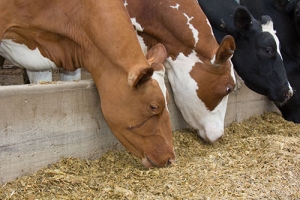The solution for medium and large scale farms
The top 10 TMR troubles

“There are 10 factors in the TMR loading and mixing process that can contribute to TMR variation,” noted Tom Oelberg, Diamond V, at the Tri-State Dairy Nutrition Conference.
- Worn mixer augers, kicker plates and knives – The easiest way to evaluate auger wear is to look for feed under horizontal augers or reels and to look for the feed ring inside vertical mixers. The degree and speed of wear depends on the size of the herd and the amount of hay, baleage or straw fed.
- Mix time after adding the last ingredient– One of the most common mistakes is a lack of mix time after adding the last ingredient. With trucks/tractors running at nearly full power, mix for three to five minutes postingredient addition.
- Unlevel mixers – Unlevel mixers cause migration of the heaviest and most dense materials to the lowest section of the mixer wagon.
- Loading position on the mixer box – When feed is dumped in either end of a mixer wagon it is not completely incorporated. If mixing time rises to compensate for loading position, then you run the risk of reducing the TMR’s effective particle size.
- Load size – Overfilling occurs when the mixer is undersized, pen counts are inaccurate, or when forage change drastically. Underfilling of vertical mixers occurs when the TMR doesn’t reach the top of the augers; running the augers at a higher RPM can help mix small loads better.
- Hay quality and processing – Poor hay quality and inadequate processing create inconsistency.
- Loading sequence – Lower-density feeds and those with a larger particle size are loaded first; followed by dry feed, wet feeds and finally liquids.
- Liquid distribution – Liquid should be added last to prevent balling or clumping of dry ingredients.
- Vertical mixer auger speed – Mix quality and production improved after the vertical auger speed was amended with proper engine speed and mixer gear box settings.
- Forage restrictor settings on vertical mixers – When properly set, forage restrictors improve hay processing without impeding mix quality.
Source: http://www.hoards.com
User Comments
Other article





















